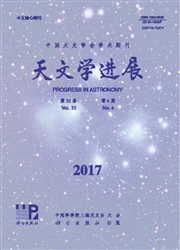

 中文摘要:
中文摘要:
VLBI是进行高分辨率脉冲星观测研究的重要手段。脉冲星信号是非常微弱的脉冲序列,其VLBI观测面临多种挑战。在数据相关过程中采用有效技术提取脉冲星信号可提高观测成功率和精度。DiFX(Distributed FX—style Software Correlator)是目前国际上流行的开源软件相关处理机,它采用非相干消色散技术和“脉冲星数据分箱技术”(Pulsar Binning),在脉冲星VLBI观测数据的相关处理方面具有优异的性能。介绍了DiFX的构架,安装、调试方法,并对利用DiFX处理脉冲星VLBI观测数据的进展情况进行论述。利用单机环境下的DiFX,在普通模式和PulsarBinning模式下对中国VLBI网(CVN)第一次脉冲星观测数据进行相关处理;利用德国马普射电天文研究所集群计算环境下的Bonn-DiFX,在PulsarBinning模式下对流量仅有2.6mJy的毫秒脉冲星PSRJ1022+1001的欧洲VLBI网(EVN)观测数据成功进行相关处理。最后,对使用DiFX处理脉冲星观测数据情况进行总结,并展望了今后CVN开展脉冲星观测研究的前景。
 英文摘要:
英文摘要:
VLBI is an important tool to perform high angular resolution observation on pulsars. The signal of most of pulsars is a series of very weak radio pulses, which are affected by interstellar medium and ionosphere heavily. So, some challenges have to be faced and overcame when the pulsar observations with VLBI are carded out. As lots of progress have been made in the field of pulsar observation with VLBI and data reduction, more and more VLBI networks take part in pulsar research and many good results have been achieved. The possibility of successful VLBI observation can be enhanced by the technique taking pulsar signals out in the correlation process, which can boot the signal to noise ratio of the observation. There is a very popular open source Distributed FX-style Software Correlator-DiFX, which is turned out to be very efficient and flexible. It has an incoherent de-dispersion module and advanced Pulsar Binning module. So it behaves very well in the correlation of VLBI observation data of pulsars. DiFX have been successfully installed on our single desktop computer. The process of installing, debugging running DiFX and the recent progress of correlating the VLBI pulsar observation data are introduced in this paper. The first time observation data (the target is PSR B0329+54) with Chinese VLBI networks (CVN) is correlated with DiFX installed on our desktop computer under the normal mode and the pulsar binning mode. By comparison, Pulsar Binning can boot the signal to noise ratio significantly. Furthermore, the correlation of our EVN observations of PSR J1022+1001, whose flux is as weak as 2.6 mJy and the period is as short as 16 ms, is done with the Bonn-DiFX on the computer cluster at the Max-Planck Institute for Radio Astronomy (MPIfR). Finally, the problems we are facing in the process of correlating pulsar VLBI observation data with DiFX are discussed. Prospects of the pulsar research with CVN are also given in the end of this paper.
 同期刊论文项目
同期刊论文项目
 同项目期刊论文
同项目期刊论文
 The kinetic power of jets magnetically accelerated from advection-dominated accretion flows in radio
The kinetic power of jets magnetically accelerated from advection-dominated accretion flows in radio COSMOLOGICAL EVOLUTION OF MASSIVE BLACK HOLES: EFFECTS OF EDDINGTON RATIO DISTRIBUTION AND QUASAR LI
COSMOLOGICAL EVOLUTION OF MASSIVE BLACK HOLES: EFFECTS OF EDDINGTON RATIO DISTRIBUTION AND QUASAR LI Influence of baryonic physics on the merger timescale of galaxies in N-body/hydrodynamical simulatio
Influence of baryonic physics on the merger timescale of galaxies in N-body/hydrodynamical simulatio SELF-CALIBRATION OF GRAVITATIONAL SHEAR-GALAXY INTRINSIC ELLIPTICITY CORRELATION IN WEAK LENSING SUR
SELF-CALIBRATION OF GRAVITATIONAL SHEAR-GALAXY INTRINSIC ELLIPTICITY CORRELATION IN WEAK LENSING SUR Exact analytical solution of the linear structure growth rate in Lambda CDM cosmology and its cosmol
Exact analytical solution of the linear structure growth rate in Lambda CDM cosmology and its cosmol First measurement of Mg isotope abundances at high redshifts and accurate estimate of Delta alpha/al
First measurement of Mg isotope abundances at high redshifts and accurate estimate of Delta alpha/al Detecting the intrinsic Baldwin Effect of the optical FeII complex in luminous Seyfert 1 galaxy fair
Detecting the intrinsic Baldwin Effect of the optical FeII complex in luminous Seyfert 1 galaxy fair INTRINSIC ELLIPTICITY CORRELATION OF SDSS LUMINOUS RED GALAXIES AND MISALIGNMENT WITH THEIR HOST DAR
INTRINSIC ELLIPTICITY CORRELATION OF SDSS LUMINOUS RED GALAXIES AND MISALIGNMENT WITH THEIR HOST DAR THE GRAVITATIONAL SHEAR-INTRINSIC ELLIPTICITY CORRELATION FUNCTIONS OF LUMINOUS RED GALAXIES IN OBSE
THE GRAVITATIONAL SHEAR-INTRINSIC ELLIPTICITY CORRELATION FUNCTIONS OF LUMINOUS RED GALAXIES IN OBSE Imprint of the interaction between dark sectors in large scale cosmic microwave background anisotrop
Imprint of the interaction between dark sectors in large scale cosmic microwave background anisotrop The anticorrelation between the hard X-ray photon index and the Eddington ratio in low-luminosity ac
The anticorrelation between the hard X-ray photon index and the Eddington ratio in low-luminosity ac IMAGES OF THE RADIATIVELY INEFFICIENT ACCRETION FLOW SURROUNDING A KERR BLACK HOLE: APPLICATION IN S
IMAGES OF THE RADIATIVELY INEFFICIENT ACCRETION FLOW SURROUNDING A KERR BLACK HOLE: APPLICATION IN S THE VELOCITY FUNCTION IN THE LOCAL ENVIRONMENT FROM Lambda CDM AND Lambda WDM CONSTRAINED SIMULATION
THE VELOCITY FUNCTION IN THE LOCAL ENVIRONMENT FROM Lambda CDM AND Lambda WDM CONSTRAINED SIMULATION Environmental effects on satellite galaxies: the link between concentration, size and colour profile
Environmental effects on satellite galaxies: the link between concentration, size and colour profile EVIDENCE FOR X-RAY SYNCHROTRON EMISSION FROM SIMULTANEOUS MID-INFRARED TO X-RAY OBSERVATIONS OF A ST
EVIDENCE FOR X-RAY SYNCHROTRON EMISSION FROM SIMULTANEOUS MID-INFRARED TO X-RAY OBSERVATIONS OF A ST Modeling Nonlinear Evolution of Baryon Acoustic Oscillations: Convergence Regime of N-body Simulatio
Modeling Nonlinear Evolution of Baryon Acoustic Oscillations: Convergence Regime of N-body Simulatio Confirmation of the Copernican Principle at Gpc Radial Scale and above from the Kinetic Sunyaev-Zel'
Confirmation of the Copernican Principle at Gpc Radial Scale and above from the Kinetic Sunyaev-Zel' Two types of softening detected in x-ray afterglows of Swift bursts: internal and external shock ori
Two types of softening detected in x-ray afterglows of Swift bursts: internal and external shock ori Simultaneous multi-wavelength observations of the TeV blazar Mrk 421 during February-March, 2003: X-
Simultaneous multi-wavelength observations of the TeV blazar Mrk 421 during February-March, 2003: X- Fermion entropy of non-uniformly rectilinearly accelerating black hole with electric and magnetic ch
Fermion entropy of non-uniformly rectilinearly accelerating black hole with electric and magnetic ch 期刊信息
期刊信息
